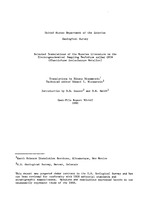Selected translations of the Russian literature on the electrogeochemical sampling technique called CHIM (chastichnoe izvlechennye metallov)
Links
- Document: Report (pdf)
- Download citation as: RIS | Dublin Core
Abstract
As part of our research into new methods for the assessment of mineral deposits, the U.S. Geological Survey has recently begun investigation of the CHIM method. As part of our studies, translation of a Russian manual on the CHIM methodology and eight articles from the Russian literature were transit ted to provide background for our own research. The translations were done by Earth Science Translation Services of Albuquerque, New Mexico, and are presented as received, without editing on our part. Below is a bibliography of the translated articles.
For approximately the past 20 years Russian geoscientists have been applying an electrogeochemical sampling technique given the Russian acronym CHIM, derived from Chastichnoe Izvlechennye Metallov which translates as "partial extraction of metals". In this technique a direct current is introduced into the earth through collector electrodes similar to "porous pots" used in electrical geophysical applications. The solution in the cathode is dilute nitric acid, and current is passed through the cathode for times ranging from 6 hours to 48 hours or more. Electrical connections to the nitric acid are made through an inner conductor that is typically spectroscopically pure graphite. At the cathode, mobile cations collect on the graphite or in the nitric acid solution, both of which serve as the geochemical sampling media. These media are then analyzed by appropriate methods for the ions of interest. In most applications of the CHIM method only mobile cations are sampled, although Russian literature does refer to collection of anions as well. More recently the CHIM method has been applied by the Peoples Republic of China and the Indian Geological Survey.
The literature indicates that the method has advantages over other geochemical sampling techniques by providing increased sensitivity to the metals being searched for, especially where deposits are covered by substantial overburden. In some cases success has been claimed with overburden in excess of 500 meters. The technique appears to have been applied principally to exploration for base- and precious-metal deposits, but does not appear to be limited to these. References are made in the literature to its application in the search for nickel, cobalt, molybdenum, uranium, tin, REE, tungsten, berylium, and oil and gas.
| Publication type | Report |
|---|---|
| Publication Subtype | USGS Numbered Series |
| Title | Selected translations of the Russian literature on the electrogeochemical sampling technique called CHIM (chastichnoe izvlechennye metallov) |
| Series title | Open-File Report |
| Series number | 90-462 |
| DOI | 10.3133/ofr90462 |
| Year Published | 1990 |
| Language | English |
| Publisher | U.S. Geological Survey, |
| Description | 172 p. |


